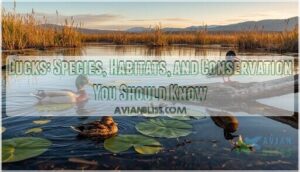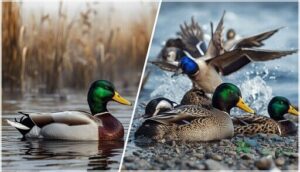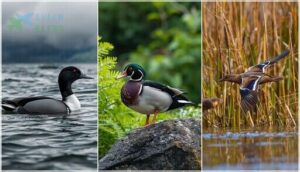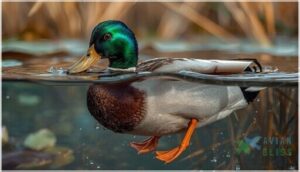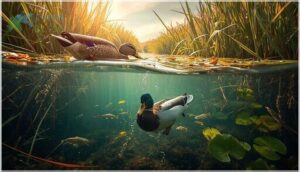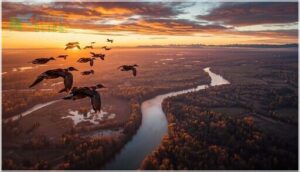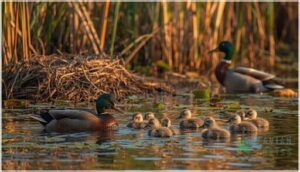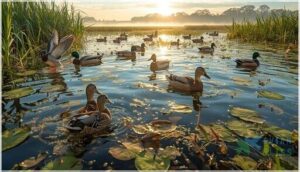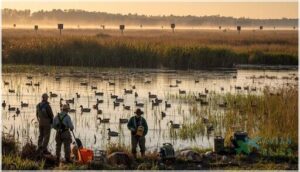This site is supported by our readers. We may earn a commission, at no cost to you, if you purchase through links.
You’ll spot ducks on every continent except Antarctica, yet most people know surprisingly little about these aquatic birds beyond bread-tossing at the local pond.
The Anatidae family encompasses 174 species—from Arctic-breeding divers to tropical perching ducks—each with specialized bills, webbed feet, and waterproof plumage systems that let them thrive in wetlands worldwide.
Climate shifts are now rewriting their ancient migration routes, pushing some species toward earlier spring arrivals while habitat loss threatens populations that once numbered in the billions.
Understanding what makes a duck a duck—and how dabbling species differ from diving specialists—reveals why these birds matter far beyond your neighborhood park.
Table Of Contents
- Key Takeaways
- What Are Ducks?
- Duck Classification and Taxonomy
- Common Duck Species
- Rare and Endangered Ducks
- Duck Anatomy and Adaptations
- Duck Feeding Habits
- Duck Migration Patterns
- Duck Reproduction and Life Cycle
- Ducks in Wetland Ecosystems
- Duck Conservation Initiatives
- Frequently Asked Questions (FAQs)
- What are five facts about ducks?
- What are female ducks called?
- What are the 3 ducks called?
- What does “duck” mean spiritually?
- What is a female duck called?
- How old can a duck live?
- What are 5 facts about ducks?
- Are ducks good pets?
- What is the life cycle of a duck?
- What is the difference between a duck and a goose?
- Conclusion
Key Takeaways
- Ducks split into distinct feeding guilds—dabbling species tip-up in shallow water under 45 cm while diving specialists plunge over a meter deep, a habitat partitioning strategy that shapes where you’ll find each group across wetlands worldwide.
- Conservation wins like the Laysan duck rebound from seven birds to 500+ prove that targeted habitat restoration and translocation programs can reverse even catastrophic population crashes when backed by persistent monitoring.
- Climate shifts are rewriting ancient migration timing, pushing species toward earlier spring arrivals and forcing northern range expansions, while habitat loss has already wiped out half of North America’s original 113 million wetland acres.
- Ducks function as wetland engineers through seed dispersal across up to 65 km daily, nutrient cycling, and invertebrate regulation—ecosystem services that make them reliable indicators of overall wetland health and biodiversity.
What Are Ducks?
You’ve probably seen ducks paddling around ponds or heard them quacking overhead, but there’s more to these birds than meets the eye. They’re waterfowl with some pretty clever adaptations that help them thrive in wet environments across the globe.
Let’s break down what makes a duck a duck, from their basic build to where you’ll find them around the world.
Basic Definition
Ducks belong to the Anatidae family—aquatic birds you’ll spot floating, diving, or dabbling in wetlands worldwide. They’re waterfowl with a knack for making a living on the water, but they’re not just one tidy group:
- True ducks fall under the subfamily Anatinae, covering most of Anatidae’s 174 species.
- Waterfowl classification separates them from their longer-necked cousins—geese and swans.
- Taxonomic status places them in Anseriformes, but “duck” isn’t strictly monophyletic; it’s more of a useful label than a rigid branch on the family tree.
Understanding the Anatidae family is essential for effective conservation efforts.
Key Physical Traits
You’ll recognize these birds by their compact bodies—most adults stretch 30–65 cm and weigh under 1.6 kg. Bill structure varies: broad, flattened bills with serrated edges let dabbling ducks filter tiny prey, while diving species sport more specialized shapes. Webbed feet power their swimming, and body proportions differ between species—diving ducks are rounder, dabblers more elongated.
Feather colors? Males flash bright patterns; females wear muted browns for camouflage. The unique characteristics of waterfowl, including their waterproof plumage systems, play a vital role in their ability to thrive in various environments.
Global Distribution
Those webbed feet carry ducks across every continent except Antarctica—from Arctic tundra to tropical wetlands. You’ll find the highest species diversity between 45° and 70° north, where temperate zones host over 20 species in single communities.
Major flyways funnel billions along Continental Spread routes: Pacific, Central, Mississippi, and Atlantic corridors link breeding grounds to wintering areas spanning thousands of miles.
Duck Classification and Taxonomy
You can’t lump all ducks into one bucket—they’ve evolved into distinct groups with different lifestyles and feeding strategies. Scientists split them into categories based on how they hunt for food, where they perch, and how closely they’re related to other waterfowl like geese and swans.
Here’s how the main groups break down.
Dabbling Vs. Diving Ducks
You’ll spot two major foraging camps in waterfowl ID: dabbling ducks tip-up in shallow water under 45 cm, grabbing seeds and invertebrates from the surface, while diving ducks plunge 0.5 to 1.8 meters deep, hunting benthic prey with legs set farther back.
This habitat partitioning splits duck species between shallow marshes and deeper lakes, shaping where you’ll find them feeding.
Perching Ducks
Tree roosting sets these waterfowl apart—species like the wood duck grip branches with sharp claws, nesting in cavities up to 15 meters high. You’ll find them where forest meets water:
- Aix genus (wood duck, mandarin) – long claws for climbing
- Cairina (Muscovy) – tropical forest rivers, 1.5–3 kg mass
- Nettapus (pygmy geese) – smallest perchers, 260–300 g
- Cavity nesters – clutches of 8–15 eggs
- Agile fliers – broad wings navigate dense woodland
These dabbling ducks bridge aquatic and arboreal worlds, their perching behavior once grouping them taxonomically before DNA revealed convergent evolution across duck species.
Geese and Swans Distinctions
Size separates these Anatidae cousins fast—swans clock in at 10–15 kg with 3-meter wingspans, while geese average 3–6 kg and 1.8 meters.
You’ll spot the difference in feeding habits: swans dive for submerged plants, whereas geese graze crops. Migration patterns also vary—geese form massive flocks, while swans travel in family units. Socially, both pair for life, but geese tolerate crowds more readily.
Flight behaviors differ too—swans need longer runways, whereas geese launch quickly.
| Feature | Swans | Geese |
|---|---|---|
| Neck Length | Up to 1.5× body length | Short, thick |
| Beak Shapes | Long, flattened | Short, triangular |
| Primary Diet | Aquatic vegetation (80%+) | Terrestrial grasses, grains |
| Flock Size | Small family groups | Hundreds to thousands |
Common Duck Species
Now that you know how ducks are grouped, you’re probably wondering which species you’re most likely to spot. Some ducks are everywhere—you’ll find them in city ponds, coastal marshes, and prairie wetlands across the continent.
Let’s look at a few common species and what makes each one stand out.
Mallard
You know the mallard—it’s that classic duck showing off a green head and rusty chest, practically the poster bird for ducks worldwide. With roughly 19 to 27 million mature individuals out there, mallards dominate wetlands, city ponds, and agricultural fields across continents. They’re opportunistic omnivores, so their diet shifts on the fly depending on what’s available.
- Males sport bright green heads with thin white collars
- Females wear mottled brown plumage for camouflage
- Webbed feet power surface dabbling and shallow dives
- Migration routes can stretch over 1,400 kilometers in autumn
- Urban birds adapt quickly to parks and anthropogenic food sources
Northern Pintail
The Northern Pintail cuts a lean silhouette—long neck, pointy tail, circumpolar breeding range—but don’t let its elegance fool you.
This waterfowl species has nosedived over 70% since the 1960s. Habitat preservation can’t keep pace with prairie drainage and drought.
Population trends scream “tipping point,” yet conservation efforts scramble to protect breeding ecology before adaptive harvest management shuts hunting seasons for good.
Population trends scream tipping point as conservation efforts race to protect breeding ecology before hunting seasons close for good
Blue-winged Teal
Blue-winged Teal might be early-fall sprinters in avian migration patterns, but their breeding habits just crashed through a two-decade low—4.4 million birds in 2025, 13% under the long-term mean.
You’ll spot these waterbirds in prairie pothole wetlands, where foraging strategies shift from invertebrates to seeds during spring migration.
Habitat preservation can’t reverse the slide fast enough to meet harvest thresholds.
Regional Species Highlights
Regional flyways carve North America into distinct waterbird ecology zones. Alaska’s sea duck habitats crashed 30% below averages in 2025, while the Boreal Forest surged 44% above.
Island endemics, like Hawaii’s koloa maoli, face hybridization threats with just 2,200 birds remaining.
Duck population trends reveal uneven conservation efforts. California’s breeding ducks jumped 27% after habitat improvements, proving targeted action shapes avian migration patterns across regional flyways.
Rare and Endangered Ducks
Not all ducks are thriving in the wild. Some species face serious threats from habitat loss, climate change, and human activity.
Let’s look at which ducks are struggling, what their conservation status tells us, and how some have made surprising comebacks.
Threatened Species
Vulnerability stalks the duck world harder than you’d think. When you scan the global roster, you’ll find dozens of species clinging to survival by a thread. Here’s what you need to know:
- White-winged duck: Roughly 150–400 individuals left, with an 80% crash over 26 years
- Baer’s pochard: 150–700 mature birds scattered across fragmented East Asian wetlands
- Laysan duck: 500–700 survivors trapped on Hawaiian atolls
- Blue duck: 1,500–2,500 individuals inhabiting New Zealand’s rivers
These endangered lists reveal how habitat preservation and wildlife conservation aren’t abstract—they’re life-or-death for entire duck species.
Conservation Status
The big picture for duck species? The IUCN Red List tracks over 160 species, and about 13% of all birds land in threatened categories—Vulnerable, Endangered, or Critically Endangered. Wetland degradation and habitat loss hammer island specialists hardest. Recent surveys show a 12% drop in total duck numbers and a brutal 23% decline in mallards between 2019 and 2022, driven by drought, climate impact, and shrinking breeding grounds. Wildlife conservation and habitat preservation strategies aren’t optional—they’re the only brake on species extinction and biodiversity loss.
| Threat Driver | Impact on Duck Species |
|---|---|
| Wetland loss | 16.8 million acres gone since the 1950s |
| Climate pressures | Drought cuts breeding habitat, shifts ranges |
| Habitat fragmentation | Isolates populations, accelerates decline |
Notable Recovery Efforts
When decline hits bottom, you can still turn species around. Laysan ducks bounced back from just 12 birds after translocations to Midway Atoll—wildlife recovery in action. Madagascar pochards hatched in captivity in 2011, then returned to Lake Sofia by 2018.
Habitat restoration techniques, like artificial islands at Chonghu Wetland, give Baer’s pochard safe nesting sites. Ducks Unlimited and NAWMP partners restored 15.7 million acres, proving wetlands conservation and species reintroduction work.
Duck Anatomy and Adaptations
Ducks aren’t just floating around looking pretty—their bodies are built like specialized tools for life in the water. Everything from their sleek feathers to their oddly shaped bills fulfills a specific purpose you mightn’t expect.
Let’s break down the key features that make these birds so well-equipped for their aquatic lifestyle.
Body Structure
You’ll notice a duck’s skeletal system packs serious design. 14 to 15 cervical vertebrae give the neck surprising flex, while sturdy tibiotarsi and reinforced humeri handle everything from crouched landings to wing-heavy takeoffs.
Webbed feet spread wide thanks to suppressed cell death during development, boosting paddle power.
The respiratory system runs nine air sacs that keep airflow unidirectional, fueling marathon migrations and seamless buoyancy in water birds across duck species.
Plumage and Coloration
Feather structure in duck species delivers wild contrasts—mallard drakes flash iridescent colors from melanin pigments arranged in tight hexagonal grids, while hens stick with camouflage browns.
You’ll spot plumage variation driven by color genetics: males undergo two molts yearly, swapping flashy breeding plumage for drab eclipse feathers.
This ornithology trick aids bird identification and reveals how avian behavior shapes species identification through visual signals.
Webbed Feet and Bill Types
You can spot a duck’s lifestyle just by checking its feet and bill. Webbed foot anatomy powers diving mechanics—those three-toed paddles generate thrust through lift, not drag, while bill morphology reveals everything about waterbird feeding habits.
Dabbling duck species filter tiny invertebrates through fine lamellae, while diving types pack broader webbing for serious foot propulsion. It’s aquatic adaptations in action, and your best bird identification technique for duck species in California.
Adaptations for Aquatic Life
You’ll see waterproofing in action when preen gland oil coats every feather—that’s how ducks float and stay warm in near-freezing water. Respiratory systems handle oxygen storage for deep dives, while thermoregulation keeps their core at 40°C even when their feet touch ice.
- Feather waterproofing traps insulating air layers that boost buoyancy and block heat loss
- Nictitating membranes work like built-in goggles for clear underwater vision
- Countercurrent heat exchange in leg vessels prevents frostbite during winter swims
- Aerodynamic bodies cut drag for locomotor efficiency whether you’re watching dabbling duck species in California wetlands or tracking waterfowl conservation efforts
These sensory adaptations and structural tweaks make waterbird feeding habits possible across every habitat where wetland ecology and conservation matter.
Duck Feeding Habits
Ducks aren’t picky eaters, but they’ve got their own clever ways of finding food depending on where they live and what they’re built for. Some dabble at the surface while others disappear underwater for minutes at a time.
Here’s how different ducks fill their bellies and what they’re actually munching on out there.
Dabbling and Surface Feeding
You’ll recognize dabbling ducks by their signature upside-down pose—tail up, head submerged—as they surface-forage in water shallower than 40 cm. Mallards and other dabbling species feed most efficiently at depths under 20 cm, where they consume seeds, aquatic vegetation, and invertebrates.
During duck migration patterns, these surface foraging behaviors intensify in managed wetlands that provide ideal forage quality for waterfowl conservation efforts.
Diving and Underwater Foraging
Unlike their dabbling cousins, diving ducks plunge completely underwater—some species hit depths near 60 meters chasing prey you’d never reach from the surface. Their dive behavior and feeding adaptations pack serious muscle enzymes for sustained foraging strategies in submerged habitats.
During duck migration patterns, these specialists target benthic invertebrates in deeper waterfowl habitats, where wetland ecology and conservation efforts protect biodiversity preservation hotspots.
Diet Variations by Species
You’ll find dietary adaptations driving duck migration and bird behavior across every wetland. Mallards balance 70% plant foods with invertebrates, while sea duck specialists hammer bivalves in coastal waterfowl habitat—foraging strategies shaped by nutrient requirements and food web dynamics.
Breeding females shift protein intake to 99% in blue-winged teal, proving species nutrition fuels avian diversity through wildlife management and seasonal demands.
Duck Migration Patterns
Ducks don’t just sit around the same pond year-round—they’re travelers. Some species fly thousands of miles between breeding and wintering grounds, following routes shaped by geography and food availability.
Let’s look at how these journeys break down across flyways, epic long-haul trips, and the seasonal rhythms that keep ducks on the move.
Major Flyways
You won’t believe it, but North America divides its duck highways into four major flyways—Atlantic, Mississippi, Central, and Pacific—each coordinating waterfowl habitat and flyway management across borders. The Mississippi Flyway alone manages over half the continent’s migration patterns, making waterbird monitoring and flyway conservation essential.
Meanwhile, Africa and Eurasia run three massive corridors—East Atlantic, Black Sea–Mediterranean, and West Asian–East African—tracking wildlife management and wetland ecology across continents.
Long-Distance Migrations
Some ducks put marathoners to shame. Northern pintails clock over 4,000 miles one-way from Alaska to Mexico, while blue-winged teal push 5,000 miles to Chile—serious distance records linking habitat corridors across continents.
Flight routes demand smart stopover ecology; your average duck covers 300 to 500 miles daily during migration patterns, but with tailwinds, they’ll pull off 800-mile days.
Wildlife management practices and waterfowl management now track these migratory patterns to boost habitat conservation where it counts most.
Seasonal Movements
Beyond those epic transcontinental flights, you’ll notice ducks responding to weather cues and photoperiod effects throughout the year. Temperature drops and snow depth trigger autumn departures, while spring warming shifts ranges northward. Climate shifts now delay fall movements and advance spring arrivals—altering migratory patterns that shaped waterfowl management and habitat conservation for generations.
- Minimum daily temperature drives initial autumn migration, with each 1 °C drop boosting departure probability by 29%
- Snow depth increases migration likelihood by 80% per centimeter, forcing birds toward open water and food
- Photoperiod effects regulate fat accumulation and breeding cycles, cueing seasonal movements months in advance
- Climate shifts have pushed mallard wintering ranges north to the Great Lakes region by mid-century projections
- Bird watching data confirm earlier fall peaks at northern sites, reflecting habitat changes under warming conditions
Duck Reproduction and Life Cycle
Duck reproduction isn’t just about eggs and ducklings—it’s a fascinating cycle that starts with elaborate courtship displays and ends with newly independent birds ready to take on wetland life. Understanding how ducks pair up, build nests, and raise their young gives you real insight into what makes these birds so adaptable and successful.
Here’s what you need to know about how ducks bring the future offspring into the world.
Courtship and Pair Bonds
Most duck romance isn’t the fairytale you’d expect—about half of waterfowl species stick together for just one breeding season. American Wigeons and Gadwalls pair up by late November, while Wood Ducks show off elaborate displays.
You’ll see Mallards, Northern Pintails, and Gadwalls courting hard from December through early spring, with males outnumbering females and competing fiercely.
Here’s the kicker: despite these courtship displays and social pair bonding, genetic monogamy is rare—over 30% of clutches have multiple fathers, proving mate selection and actual mating strategies tell very different stories.
Nesting and Incubation
Once the female settles on a spot, she’s all in—constructing the nest over 3 to 10 days in thick vegetation. Incubation periods vary by bird species:
- Mallards sit for 23–30 days, rarely leaving their clutch
- Teal hatch faster at 20–23 days
- Egg temperature must stay at 35–40°C for survival
- Nest predation claims roughly 24–44% of attempts
Brood survival hinges on habitat loss prevention and ecological balance.
Duckling Development
Within 24 hours of hatching, ducklings leave the nest ready to walk, swim, and forage—classic precocial behavior you’ll see in waterfowl everywhere. Brood behavior keeps them close to mom during those vulnerable first 14 days when predation peaks.
Duckling nutrition starts protein-heavy for feather growth and thermoregulation as down gives way to juvenile plumage by week two. Fledging stages wrap up around 54 days, transforming hatchlings into flight-ready birds for wildlife conservation and bird watching enthusiasts alike.
Ducks in Wetland Ecosystems
Ducks aren’t just living in wetlands—they’re shaping them. These birds play surprisingly critical roles in maintaining the balance of aquatic ecosystems, from nutrient cycling to seed dispersal.
Let’s look at how ducks fit into wetland life, what they actually need to thrive, and what happens when those habitats disappear.
Ecological Roles
You mightn’t realize it, but ducks are wetland engineers that shape entire ecosystems. Through seed dispersal, they connect isolated habitats—mallards can move viable seeds up to 65 km in a day.
They regulate aquatic invertebrates, transport plant propagules across landscapes, and serve as living indicators of wetland health. Their foraging and movement patterns directly influence biodiversity conservation and ecosystem restoration success.
Wetland Habitat Needs
You need wetland complexes that balance water depth, vegetation, and food if you want thriving waterfowl populations. Managed impoundments maintain 10–25 cm depths for dabbling access.
Habitat restoration targets semipermanent basins with emergent marshes—cattails, bulrushes—rooted in 15–90 cm water. Wetland management through drawdowns and moist-soil units fosters ecosystem balance.
Conservation strategies prioritize landscape context: over 12 ponds per square mile dramatically boosts breeding densities and wetlands protection outcomes.
Impact of Habitat Loss
You’re watching habitat destruction unravel wetland ecosystems right now. Since European settlement, the U.S. has lost 113 million acres—half its original wetlands—while duck populations dropped 30% since 2017. Ecosystem disruption hits hard when:
- Wetland degradation strips 80,000 acres of prime habitat annually
- Agricultural expansion replaces nesting cover with cropland
- Species decline accelerates as coastal marshes vanish to sea-level rise
- Urbanization fragments remaining patches by 72% through 2100
Conservation strategies through wetlands conservation and wildlife habitat protection remain your best shot at reversing these losses.
Duck Conservation Initiatives
You can’t talk about ducks without talking about the work being done to keep them around. Conservation efforts range from restoring the wetlands they depend on to setting rules that protect breeding populations.
Here’s what you need to know about the major initiatives shaping duck conservation today.
Wetland Restoration
You’ve likely heard wetland restoration tossed around conservation circles, but here’s what it actually delivers: restored duck ponds create waterfowl habitat, trap sediment, filter nutrients, and recharge groundwater.
These ecosystem services reduce flooding while improving water quality. Restoration methods like reestablishing hydrology and emergent vegetation turn degraded sites into functional wildlife habitat.
One Illinois River project generated nearly $2 million in annual benefits—proof that habitat creation pays off big.
Ducks Unlimited Efforts
One conservation organization towers over the wetland landscape: Ducks Unlimited. Since 1937, they’ve protected or restored over 18 million acres across North America.
In 2024 alone, they delivered 1 million acres of conservation through environmental partnerships and wildlife management strategies.
Their conservation funding model—$333 million in revenue, 80 percent directed to habitat restoration—makes wetland preservation work at scale.
Hunting Regulations
Duck hunting regulations balance harvest with conservation through the Migratory Bird Treaty Act’s regulatory framework. Season dates run from late September through January 31, with bag limits capping daily take at six ducks in many states.
Adaptive harvest management uses breeding population surveys to set liberal, moderate, or restrictive seasons annually. These wildlife hunting regulations keep waterfowl habitat management and conservation efforts aligned with sustainable hunting practices.
Public Education and Advocacy
Beyond regulations, conservation awareness depends on public engagement. You can join advocacy strategies through Ducks Unlimited’s community outreach programs—youth memberships start at fifteen dollars, building environmental literacy early.
Their wildlife conservation strategies certification reaches students in fourteen states, connecting bird species conservation to sustainable conservation practices.
This environmental protection policies approach transforms supporters into informed advocates, ensuring wetlands conservation outlasts any single generation.
Frequently Asked Questions (FAQs)
What are five facts about ducks?
You’ll find over 170 duck species worldwide. The mallard alone spans 20 million square kilometers. Migratory journeys reach 5,000 miles. Waterfowl conservation through Ducks Unlimited has protected 19 million acres since
What are female ducks called?
You’ll hear the term “hen” for a mature female duck—whether she’s a Mallard, Wood Duck, Muscovy Duck, American Wigeon, or Gadwall. Drakes are males; ducklings are the youngsters.
What are the 3 ducks called?
When ornithologists sort waterfowl, they group species into three main types: Dabbling Ducks (like the Mallard), Diving Ducks, and Perching Ducks (including Wood Duck and Muscovy Duck)—a practical Waterfowl Types classification system.
What does “duck” mean spiritually?
Spiritually, ducks represent balance and adaptability as liminal beings moving between worlds. They symbolize emotional depth, fertility icons, and guidance animals, especially in Asian traditions valuing fidelity and abundance.
Through Wildlife Preservation efforts, these traditions support Biodiversity, further emphasizing the duck’s role as a symbol of harmony and prosperity.
What is a female duck called?
You’d call her a hen—not your backyard chicken, but the proper term for any adult female duck, whether she’s a Mallard, American Wigeon, or Gadwall sporting camouflage plumage.
How old can a duck live?
You’ll find most wild ducks clock 5 to 10 years, wrestling predators and weather at every turn. Domestic ducks, though? They can cruise past 12 years—some even hit 20 with solid care.
What are 5 facts about ducks?
You’ll spot over 170 duck species worldwide, with mallards and diving ducks thriving in restored wetlands.
Duck migration spans four flyways, connecting breeding grounds to wintering sites—proof that waterfowl habitat conservation works.
Are ducks good pets?
Think twice before you quack open this can of worms—domestic ducks demand daily care, hefty backyard fencing, crystal-clear water quality, and long-term commitment that tests even devoted keepers, despite their charm.
What is the life cycle of a duck?
You’ll see egg incubation lasting about 26–30 days, then ducklings hatch ready to swim within 24 hours. They fledge around 7 weeks, reach maturity at one year, and live 5–10 years in the wild.
What is the difference between a duck and a goose?
Geese tower over ducks—weighing up to 9 kg versus 3 kg—and sport longer necks plus shorter bills.
You’ll spot geese grazing on land, while ducks dabble in water, displaying flashier plumage than their honking cousins.
Conclusion
When the Laysan duck population crashed to just seven birds in 1911, biologists didn’t write it off—they rebuilt wetlands and monitored every nest. Today, over 500 thrive across multiple islands.
You can drive similar wins by supporting habitat restoration, respecting migration corridors, and pushing for science-backed hunting limits. Ducks won’t save themselves, but your informed action—whether donating, advocating, or simply learning more—keeps these species flying for generations ahead.
- https://www.newswire.ca/news-releases/2023-duck-populations-estimated-at-32-3-million-855036415.html
- https://deltawaterfowl.org/whats-new/news/2025-state-waterfowl-breeding-population-survey-roundup/
- https://en.wikipedia.org/wiki/List_of_Anseriformes_by_population
- https://www.fao.org/poultry-production-products/production/poultry-species/ducks/en/
- https://www.statista.com/statistics/1108405/thailand-duck-meat-production/

